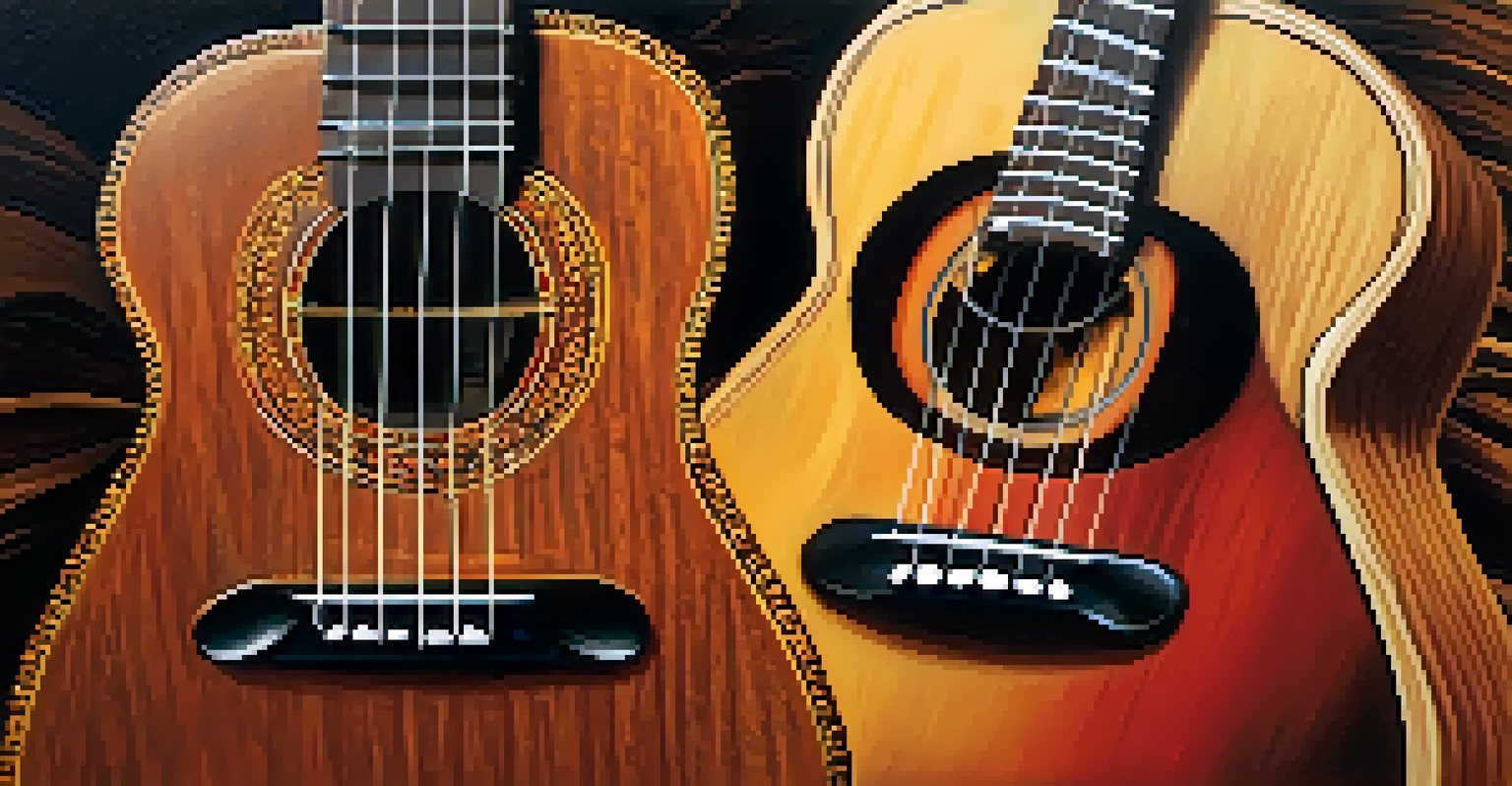Innovative Ukulele Duet Techniques to Impress Your Audience

Understanding the Power of Harmony in Duets
Harmony is the backbone of any duet, and when it comes to ukuleles, it can create rich, resonant sounds that captivate listeners. By layering melodies, you can bring depth to your performance, making it more engaging and dynamic. Imagine the sound of two voices blending seamlessly, much like a perfectly brewed cup of coffee that warms your soul.
Music can change the world because it can change people.
To harness the power of harmony, try experimenting with different chord progressions. One player can strum the chords while the other plays a melodic line, creating an interplay that keeps the audience on their toes. This technique not only showcases your musicality but also enhances the overall experience for everyone listening.
Remember, the beauty of harmony lies in its simplicity. You don’t need to be a virtuoso to create stunning harmonies; sometimes, a few well-placed notes can evoke powerful emotions. So, grab your ukulele and start exploring the world of harmony together!
Incorporating Rhythm to Create Unique Sounds
Rhythm is more than just keeping time; it's the heartbeat of your performance. By playing with different rhythmic patterns, you can add excitement and energy to your duet. Think of it as the dance of your ukuleles, where each strum and pluck tells a story that draws in your audience.

Experimenting with syncopation can introduce unexpected twists to your music. When one player emphasizes beats that are usually weak, it creates a lively and offbeat feel that keeps listeners engaged. Consider how a sudden change in rhythm can feel like a surprise party – it’s all about the anticipation and excitement.
Harnessing Harmony for Depth
Experimenting with harmony in duets adds richness and emotional depth to your performance.
To master rhythm in your duets, practice together regularly. The more you play with each other, the more you’ll naturally develop a sense of timing that feels organic. Soon, you’ll be creating rhythms that not only impress but also resonate with your audience.
Using Fingerstyle Techniques for a Personal Touch
Fingerstyle playing can transform your ukulele duet into a more intimate experience. Instead of strumming, using your fingers to pluck the strings allows for greater expression and nuance in your music. This technique can evoke a sense of storytelling, drawing listeners into the emotions behind your performance.
The beautiful thing about music is that it transcends language.
Imagine the feeling of a gentle breeze as you play a soft fingerstyle melody; it’s soothing and inviting. One player can take the lead with a melodic line while the other provides a delicate harmonic backdrop, creating a serene atmosphere that resonates deeply with your audience.
To get started with fingerstyle, practice basic patterns and gradually incorporate them into your duets. With time, you’ll find that your ability to connect with your audience will grow, as they become more attuned to the subtleties of your sound.
Exploring Call-and-Response for Engagement
Call-and-response is a fun and interactive technique that invites your audience to participate. It’s like a musical conversation where one player poses a question, and the other provides an answer. This back-and-forth creates a dynamic atmosphere that can energize your performance.
You can start by having one player play a short melody, followed by the other responding with a complementary phrase. This method not only showcases your individual skills but also highlights your ability to work together as a duet. It’s a musical dialogue that can leave your audience wanting more.
Engaging Dynamics for Emotion
Mastering dynamics allows you to create dramatic contrasts, enhancing the emotional connection with your audience.
To make the most of call-and-response, encourage your audience to join in on simple phrases. This inclusive approach can enhance the overall experience, turning a performance into a memorable event where everyone feels part of the music.
Mastering Dynamics for Emotional Impact
Dynamics play a crucial role in how your music is perceived. By varying the volume and intensity of your playing, you can create dramatic contrasts that elicit a range of emotions. Think of it as painting with sound; soft passages can evoke tenderness, while louder sections can convey passion and excitement.
In a duet, one player can take the lead in dynamics while the other supports with contrasting volume. For example, if one player plays softly, the other can accentuate the moment by playing more forcefully, creating a captivating tension that keeps the audience engaged. This interplay can be likened to a thrilling roller coaster ride, full of ups and downs.
To practice dynamics, focus on how you can communicate feelings through your playing. Experiment with crescendos and decrescendos to see how they affect the mood of your pieces. Over time, you’ll find that mastering dynamics will significantly enhance your audience’s emotional connection to your performance.
Innovative Use of Effects Pedals
Effects pedals can transform your ukulele sound, adding layers of complexity and creativity to your duet. From reverb to delay, these tools can enhance the atmosphere of your performance, making it feel expansive and immersive. Imagine a lush soundscape that envelops your audience like a warm embrace.
Each player can experiment with different pedals, creating unique sounds that complement each other. For example, while one player uses a distortion pedal for a bold, edgy tone, the other might opt for a soft delay that adds depth. This contrast can lead to a rich, textured sound that captivates listeners.
Incorporating Movement for Impact
Adding visual elements and movement to your performance makes it more dynamic and memorable for the audience.
To make the most of effects pedals, start by understanding how each one works. Experiment with settings during practice sessions to discover how they can elevate your music. With a little creativity, you’ll find that these tools can take your ukulele duet to new heights.
Playing with Tempo Variations for Surprise
Tempo variations can add an element of surprise to your performance, keeping your audience on their toes. By shifting speeds throughout your duet, you can create tension and release, much like a thrilling plot twist in a good novel. This technique invites listeners to experience the music in a new way.
One effective way to incorporate tempo changes is by alternating between fast and slow sections. For instance, a rapid, upbeat passage can lead into a slow, reflective moment, creating a captivating contrast. It’s like taking your audience on a journey, where they never quite know what’s coming next.

To practice tempo variations, try playing familiar songs at different speeds. This exercise will help you become comfortable with shifting tempos and allow you and your duet partner to explore new musical possibilities together.
Creating a Visual Performance with Movement
Engaging your audience visually is just as important as the music you play. Incorporating movement into your ukulele duet can create a dynamic performance that captures attention. Think of it as a dance, where the rhythm of your bodies complements the rhythm of your instruments.
Simple movements, like swaying to the beat or stepping forward during a solo, can enhance the overall experience. This not only keeps your audience engaged but also emphasizes the emotional aspects of your music. Imagine performing a heartfelt ballad while leaning into the music; it draws your listeners in.
To effectively incorporate movement, practice coordinating your actions with your playing. The more natural it feels, the more it will resonate with your audience. A visually engaging performance can leave a lasting impression, making your duet memorable long after the music has ended.